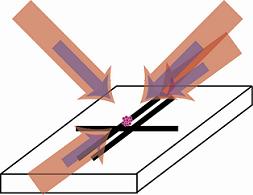
|
|
|
|
|
|
Email:
jmgrossman@smcm.edu Address: Department of Physics St. Mary's College of Maryland 18952 E. Fisher Rd. St. Mary's City, MD 20686 Phone: (240) 895-4367 Office: Schaefer 242 Lab: Schaefer 163 Research support from:  The Office of Naval Research  Research Corporation and St. Mary's College of Maryland |
Laser Cooling & Trapping: High numbers of atoms in traps

Professor Josh Grossman and his students collaborate in research with Dr. Frank Narducci of Patuxent River Naval Air Station, along with Professor Chuck Adler of St. Mary's. This research aims to harness special techniques of laser cooling and trapping of neutral atoms in order to greatly increase the number of atoms captured in a modified magneto-optical trap (MOT).
Ultracold atoms now form the basis of atomic clocks and precision sensors for magnetometry, gravimetry, and inertial guidance. Before these technologies may be deployed to the field, the entire cooling and trapping apparatus must be miniaturized. Atom chips-- microscopic magnetic traps formed by current-carrying wires on a substrate-- present one route to miniaturized, robust, integrated, ultracold-atom devices. Unfortunately, a straightforward reduction of a device's scale results in a large reduction in the number of trapped atoms, as the number of atoms captured in a magneto-optical trap (MOT) scales as the fourth power of the radius of the laser beams used in the trap. This in turn implies reduced sensitivity in the applications pursued. It is desirable, therefore, to find a method to recover a sizeable portion of the lost atoms without significantly increasing the complexity of the overall device.
Our group has proposed using a method of laser cooling that is only slightly more complex than standard methods in order to compensate for the loss of atoms due to the decreased capture volume in small-beam MOTs .